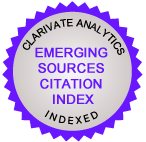Teléfonos inteligentes: oportunidades y riesgos
-
Humberto Ortega-Villaseñor
 huorvi@gmail.com
huorvi@gmail.com
Descargas
DOI:
https://doi.org/10.4067/S0718-48672022000100111Resumen
El artículo aborda el estudio de la llamada telefonía inteligente móvil ubicándola en el marco de la integración creciente de servicios digitales que se ofrecen al usuario de nuestros días. Analiza su tipología, límites y alcances, aspectos positivos y negativos, ahondando en los riesgos y consecuencias a futuro que implica constituir un sistema generador de información y datos personales de los usuarios, que son almacenados en el propio dispositivo y en las plataformas de cómputo (las llamadas nubes). Esa información íntima es susceptible de ser interpretada a través de la llamada minería de datos personales (campo de conocimiento avanzado en técnicas específicas de extracción, procesamiento e interpretación de datos). Constituye un acervo o fuente de información que ha sido desaprovechada en muchos casos para mejorar la salud, interacción humana y el aprendizaje de los usuarios. Y, muy por el contrario, ha sido utilizado por diversas corporaciones para prestar servicios de espionaje industrial, vigilancia comercial, vigilancia política o ideológica de la ciudadanía, o de intervención directa para manipular la conducta y mantener el control de consumo de segmentos específicos de la población.
Palabras Clave
AGUADO, J. M. & MARTÍNEZ, I. (2009). De la Web social al Móvil 2.0; el paradigma 2.0 en el proceso. El profesional de la información, 18(2), pp. 155-161. https://doi.org/10.3145/epi.2009.mar.05
AMADOR, J. (2015, OCTOBER 4). El mundo será socialista o no será: Gianni Vattimo. Proceso. https://publicacionesdigitales.proceso.com.mx/publication/index.html?title=proceso-2031
ASIF, M. & KROGSTIE, J. (2013, JUNE 24-27). Mobile client-side personalization [Conference session]. 2013 International Conference on Privacy and Security in Mobile Systems (PRISMS). United States. DOI: 10.1109/PRISMS.2013.6927183.
BAKIR, V., HERRING, E., MILLER, D., & ROBINSON, P. (2019). Organized Persuasive Communication: A new conceptual framework for research on public relations, propaganda, and promotional culture. Critical Sociology, 45(3), pp. 311-328. https://doi.org/10.1177/0896920518764586
BUENO, V. (2015, JULY). Only Disconnect. Le Monde Diplomatique. https://mondediplo.com/2015/07/16disconnect
CARBONELL, X., OBERST, U., & BERANUY, M. (2013). The cell phone in the twenty-first century: A risk for addiction or a necessary tool? In Miller, P. (Ed.), Principles of addiction: Comprehensive addictive behaviors and disorders Vol. 1 (pp. 901-909). Academic Press. https://doi.org/10.1016/B978-0-12-398336-7.00091-7
CARRASCO-ARAIZAGA, J. & TOURLIERE, M. (2015, JULY 11). Los mexicanos espiados hasta la cocina. Proceso. https://www.proceso.com.mx/reportajes/2015/7/11/los-mexicanos-espiados-hasta-en-la-cocina-149620.html
____ (2017, June 20). Así se negocia para que nos Vigilen. Proceso. https://www.proceso.com.mx/reportajes/2017/6/20/asi-negocia-el-gobierno-de-pena-nieto-para-que-nos-vigilen-186411.html
CASTELLS, M., FERNÁNDEZ-ARDEVOL, M., LINCHUAN-QIU, J. & SEI, A. (2006). Comunicación Móvil y Sociedad. Una perspectiva global. Ariel.
CASTRO-ROJAS, S. R. (2012). Ubicuidad y comunicación: los Smartphones. Chasqui, Revista Latinoamericana de Comunicación, 118, pp. 91-95.
https://revistachasqui.org/index.php/chasqui/article/view/197/206
CHOE, E. K., LEE, N. B., LEE, B., PRATT, W. & KIENTZ, J. A. (2014, APRIL). Understanding Quantified-Selfer's Practices in Collecting and Exploring Personal Data [Conference session]. CHI '14: Proceedings of the SIGCHI Conference on Human Factors in Computing Systems. United States.
https://doi.org/10.1145/2556288.2557372
CORREDOR-ÁLVAREZ, F. A., TIRADO-SERRANO, F. & IÑIGUEZ-RUEDA, L. (2010). ¿Bajo las riendas del teléfono móvil? Control social, normalización y resistencia. Psicologia & Sociedade, 22(1), pp. 60-69. https://doi.org/10.1590/S0102-71822010000100008
CUESTA-CAMBRA, U., CUESTA-DÍAZ, V., MARTÍNEZ-MARTÍNEZ, L. & NIÑO-GONZÁLEZ, J. I. (2020). Smartphone: en Comunicación, algo más que una adicción. Revista Latina de Comunicación Social, 75, pp. 367-381.
https://www.doi.org/10.4185/RLCS-2020-1431
D‘ALMEIDA, F. & MARGOT, D. (2018). La evolución de las telecomunicaciones móviles en América Latina y el Caribe. Serie de Desarrollo a través del Sector Privado, (4), pp. 1-54.
DAVIDAVIÄŒIENÄ–, V., RAUDELIŪNIENÄ–, J., & VIRÅ ILAITÄ–, R. (2021). Evaluation of User Experience in Augmented Reality Mobile Applications. Journal of Business Economics and Management, 22(2), pp. 467–481.
https://doi.org/10.3846/jbem.2020.13999
GALINDO, E. M. (2021, AUGUST 20). Personal interview with the university student. [Personal interview].
GSMA (2019). Leyes inteligentes de privacidad de datos. Cómo lograr los resultados deseados en la era digital.
HABIB-UR-REHMAN, M., SUN-LIEW, C., YING-WAH, T., SHUJA, J., & DAGHIGHI, B. (2015). Mining Personal Data Using Smartphones and Wearable Devices: A Survey. Sensors, 15(2), pp. 4430-4469. https://doi.org/10.3390/s150204430
HÖFLICH, J. & RÖSSLER P. (2002). El teléfono móvil y el uso del SMS por parte de los adolescentes alemanes. Revista de Estudios de Juventud, 57, pp. 79-93.
HONG, F. Y., CHIU, S. I., & HUANG, D. H. (2012). A model of the relationship between psychological characteristics, mobile phone addiction and use of mobile phones by Taiwanese university female students. Computers in Human Behavior, 28, pp. 2152–2159. https://doi.org/10.1016/j.chb.2012.06.020
IGARASHI, T., MOTOYOSHI, T., TAKAI, J., & YOSHIDA, T. (2008). No mobile, no life: Self-perception and text-message dependency among Japanese high school students. Computers in Human Behavior, 24, pp. 2311–2324.
https://doi.org/10.1016/j.chb.2007.12.001
INTERNATIONAL TELECOMMUNICATION UNION (2014). The world in 2014: ICT facts and figures.
https://www.itu.int/en/ITU-D/Statistics/Documents/facts/ICTFactsFigures2014-e.pdf
KRANZ, M., MÖLLER, A., HAMMERLA, N., DIEWALD, S., PLÖTZ, T., OLIVIER, P., & ROALTER, L. (2013). The mobile fitness coach: Towards individualized skill assessment using personalized mobile devices. Pervasive and Mobile Computing, 9(2), pp. 203–215. https://doi.org/10.1016/j.pmcj.2012.06.002
LA JORNADA (2015, FEBRUARY 12). La generación Z, con un "tren cerebral de alta velocidad que va del ojo al pulgar".
https://www.jornada.com.mx/2015/02/12/ciencias/a02n1cie
LEUNG, L. (2007). Unwillingness-to-communicate and college students‘ motives in SMS mobile messaging”. Telematics and Informatics, 24(2), pp. 115–129. https://doi.org/10.1016/j.tele.2006.01.002
LIN, T., CHIANG, Y. H. & QIAOLEI, J. (2015). Sociable People Beware? Investigating Smartphone versus Nonsmartphone Dependency Symptoms among Young Singaporeans. Social Behavior and Personality: an international journal, 43(7), pp. 1209–1216. https://doi.org/10.2224/sbp.2015.43.7.1209
MONTJOYE, Y.A., SHMUELI, E., WANG, S., & PENTLAND, A. S. (2014). openPDS: Protecting the Privacy of Metadata through SafeAnswers. PLoS ONE, 9(7), pp. 1-9. https://doi.org/10.1371/journal.pone.0098790
PALOMARES-HERRERA, M. (2017). Estudio comparado sobre transparencia y Derecho de acceso en el ámbito internacional y su influencia en España. Ius Humani: Revista de Derecho, (6), pp. 123-153.
https://dialnet.unirioja.es/descarga/articulo/5877166.pdf
PERRY, S. D. & LEE, K. C. (2007). Mobile phone text messaging overuse among developing world university students. South Africa Journal for Communication Theory and Research, 33, pp. 63–79. https://doi.org/10.1080/02500160701685417
RHEINGOLD, H. (2004). Multitudes inteligentes. La próxima revolución social. Gedisa.
RUELAS, A. L. (2010). El teléfono celular y las aproximaciones para su estudio. Comunicación y Sociedad, (14), pp. 143-167.
RUIZ-RICO, C. (2019). Análisis comparativo de la legislación iberoamericana en materia de transparencia y derecho de acceso a la información. Boletín mexicano de derecho comparado, 52(154), pp. 255-283.
https://doi.org/10.22201/iij.24484873e.2019.154.14144
SARABIA-SÁNCHEZ, F. J., AGUADO, J. M., & MARTÍNEZ-MARTÍNEZ, I. J. (2019). Privacy paradox in the mobile environment: The influence of the emotions. El profesional de la información, 28(2), pp. 1-11.
https://doi.org/10.3145/epi.2019.mar.12
SEKARA, V., ALESSANDRETTI, L., MONES, E., & JONSSON, H. (2021). Temporal and cultural limits of privacy in smartphone app usage. Scientific Reports, 11(3861), p. 1-9. https://doi.org/10.1038/s41598-021-82294-1.pag
SERRA, G., LO-SCALZO, L., GIUFFRÈ, M., FERRARA, P., & CORSELLO, G. (2021). Smartphone use and addiction during the coronavirus disease 2019 (COVID-19) pandemic: cohort study on 184 Italian children and adolescents. Italian Journal of Pediatrics, 47(150), pp. 1-10. https://doi.org/10.1186/s13052-021-01102-8
SERRA-CRISTÓBAL, R. (2015). La opinión pública ante la vigilancia masiva de datos. El difícil equilibrio entre acceso a la información y Seguridad nacional. Revista de Derecho Político, 92, pp. 73-118. https://doi.org/10.5944/rdp.92.2015.14422
SULTAN, A. J. (2014). Addiction to mobile text messaging applications is nothing to “lol” about. The Social Science Journal, 51, pp. 57–69.
https://doi.org/10.1016/j.soscij.2013.09.003
TALBOT, D. (2014). Ultraprivate Smartphones. MIT Technology Review, 117(3), pp. 35-37. https://www.technologyreview.com/technology/ultraprivate-smartphones/
TOURLIERE, M. (2015, JULY 12). Citizen Lab exhibe a la empresa de espionaje favorita del peñismo. Proceso. https://www.proceso.com.mx/reportajes/2015/7/15/citizen-lab-exhibe-la-empresa-de-espionaje-favorita-del-penismo-149750.html
TU, C.H., MCISAAC, M., SUJO-MONTES, L., & ARMFIELD, S. (2012). Is there a mobile social presence? Educational Media International, 49(4), pp. 247–261.
https://doi.org/10.1080/09523987.2012.741195
WIESE, J., DAS, S., HONG, J. I., & ZIMMERMAN, J. (2017). Evolving the Ecosystem of Personal Behavioral Data. Human–Computer Interaction, 32, pp. 447–510. https://doi.org/10.1080/07370024.2017.1295857
ZUBOFF, S. (2019). Surveillance Capitalism and the Challenge of Collective Action. New Labor Forum 2019, 28(1) pp. 10–29.
https://journals.sagepub.com/doi/full/10.1177/1095796018819461
Artículos similares
- Ramon Ramirez Ibarra, Estado, libertad e ideología: narrativas digitales de la nueva derecha para América Latina , Perspectivas de la Comunicación: Vol. 16 Núm. 1 (2023): enero - junio
- Francisco Sierra Caballero, Salomé Sola-Morales, Espacio público oposicional y ciberactivismo, una lectura materialista de la acción conectiva , Perspectivas de la Comunicación: Vol. 13 Núm. 2 (2020): julio - diciembre
- Bianca Racioppe, Julieta Párraga, Memes en Instagram: un estudio de caso de cuentas dedicadas a la producción y circulación de estas narrativas contemporáneas , Perspectivas de la Comunicación: Vol. 13 Núm. 1 (2020): enero - junio
- Arthur Ituassu, Letícia Capone, Leonardo Magalhães Firmino, Vivian Mannheimer, Felipe Murta, Comunicación política, elecciones y democracia: las campañas de Donald Trump y Jair Bolsonaro , Perspectivas de la Comunicación: Vol. 12 Núm. 2 (2019): julio - diciembre
- Eugenia Blasetti, Emma Garzonio, La representación social de los migrantes durante la pandemia de COVID-19. Un estudio de caso italiano sobre narrativas hostiles y comunicación política visual , Perspectivas de la Comunicación: Vol. 15 Núm. 2 (2022): julio - diciembre
- Francisco Sierra Caballero, Ciberactivismo y nuevos movimientos urbanos: la producción del nuevo espacio público en la política contemporánea , Perspectivas de la Comunicación: Vol. 13 Núm. 1 (2020): enero - junio
- Giacomo Buoncompagni, Entre mosaicos culturales y prácticas institucionales. Intentando construir un modelo de comunicación pública intercultural , Perspectivas de la Comunicación: Vol. 17 (2024): (Publicación continua)
- Giovanni Brancato, Melissa Stolfi, Política, asuntos de género y medios de comunicación. Un análisis de las redes sociales en la campaña para las elecciones al parlamento europeo de 2019 , Perspectivas de la Comunicación: Vol. 15 Núm. 2 (2022): julio - diciembre
- Laura Andrea Aceituno Castillo, El tratamiento periodístico de las noticias relacionadas con los virus del dengue y zika en los medios digitales de Honduras (2010-2017) , Perspectivas de la Comunicación: Vol. 12 Núm. 1 (2019): enero - junio
- Hugo Ignacio Campos Winter, Construcción mediática del proceso de gratuidad en educación superior en Chile , Perspectivas de la Comunicación: Vol. 10 Núm. 1 (2017): Enero - Agosto
También puede {advancedSearchLink} para este artículo.
Descargas
Publicado
Cómo citar
Número
Sección
Licencia
Derechos de autor 2022 Perspectivas de la Comunicación - ISSN 0718-4867

Esta obra está bajo una licencia internacional Creative Commons Atribución 4.0.
1. Política propuesta para revistas que ofrecen acceso abierto
Aquellos autores/as que tengan publicaciones con esta revista, aceptan los términos siguientes:
- Los autores/as conservarán sus derechos de autor y garantizarán a la revista el derecho de primera publicación de su obra, el cuál estará simultáneamente sujeto a la Licencia de reconocimiento de Creative Commons Reconocimiento (CC -BY 4.0)
 que permite a terceros compartir la obra siempre que se indique su autor y su primera publicación en esta revista.
que permite a terceros compartir la obra siempre que se indique su autor y su primera publicación en esta revista. - Los autores/as podrán adoptar otros acuerdos de licencia no exclusiva de distribución de la versión de la obra publicada (p. ej.: depositarla en un archivo telemático institucional o publicarla en un volumen monográfico) siempre que se indique la publicación inicial en esta revista.
- Se permite y recomienda a los autores/as difundir su obra a través de Internet (p. ej.: en archivos telemáticos institucionales o en su página web) antes y durante el proceso de envío, lo cual puede producir intercambios interesantes y aumentar las citas de la obra publicada. (Véase El efecto del acceso abierto).












